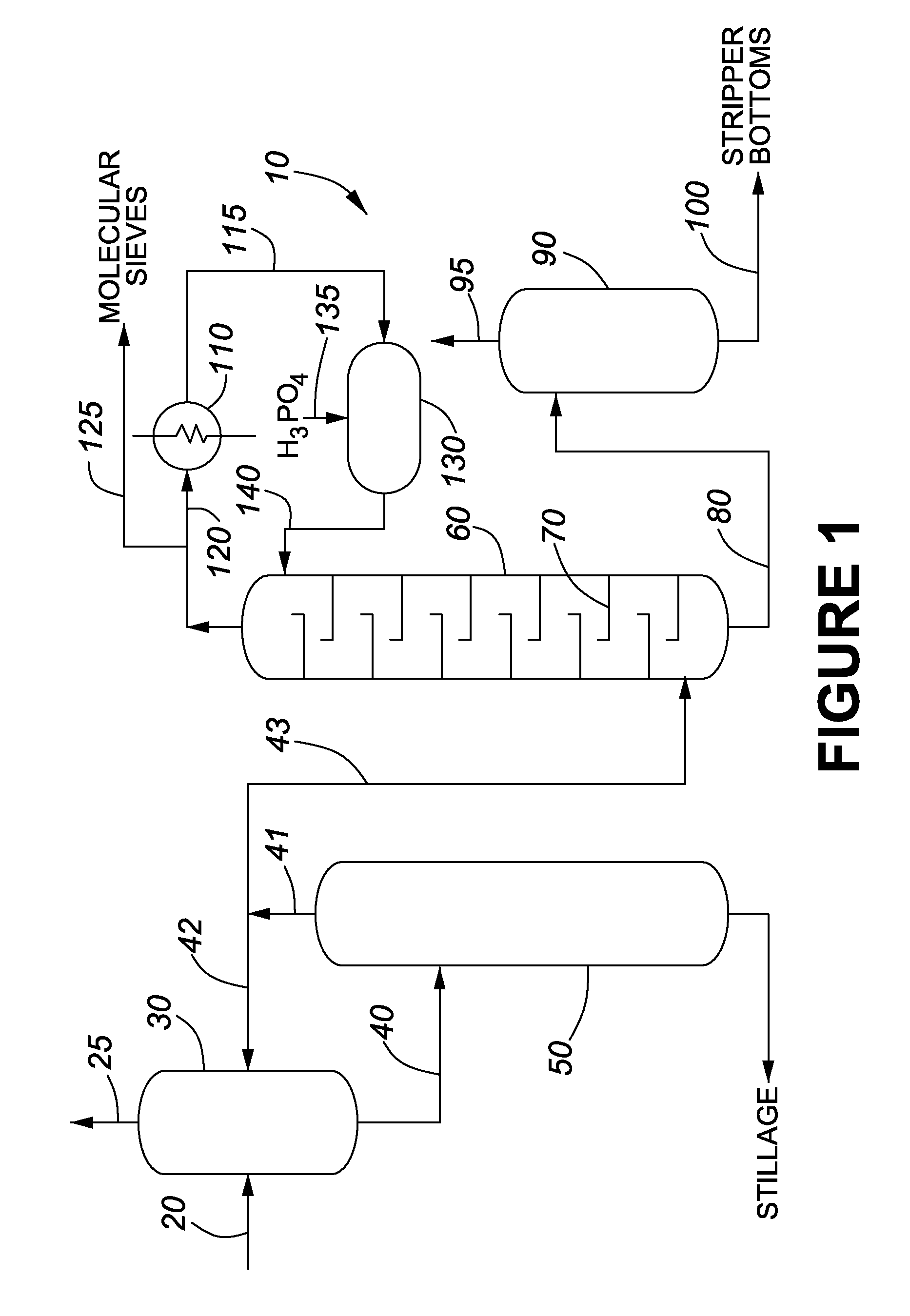Method for the production of concentrated alcohol from fermentation broths
a technology of concentrated alcohol and fermentation broth, which is applied in the direction of distillation separation, liquid carbonaceous fuels, separation processes, etc., can solve the problems of desiccant fouling and unacceptably high ph/sub>e value of concentrated ethanol product, and achieve the effect of improving the performance of molecular sieves, high phe value and reducing or preventing fouling
- Summary
- Abstract
- Description
- Claims
- Application Information
AI Technical Summary
Benefits of technology
Problems solved by technology
Method used
Image
Examples
example 1
The Production of Ethanol and Concentration of Ethanol from a Lignocellulosic Feedstock without acid Addition during Distillation
[0066]The following example serves to illustrate that the presence of ammonium salts or a combination of ammonium salts and ammonia can compromise the performance of the molecular sieves used to concentrate ethanol that is produced as a product from a lignocellulosic conversion process. In this example, the ammonium salts or a combination of ammonium salts and ammonia are produced by neutralizing an acid pretreated feedstock with ammonium hydroxide.
[0067]The first step of the process involved size reduction of the feedstock. Wheat straw was received in bales measuring 3 feet by 3 feet by 4 feet and chopped to approximately ¼ inch in size. The straw was then mixed with water and sent to a standpipe where 93% (w / w) sulfuric acid was added to reduce the pH of the straw-water mixture to about 1.2. The slurry was pumped through piping heated by direct injection...
example 2
The Production and Concentration of Ethanol from a Lignocellulosic Feedstock with Acid Addition during Distillation
[0081]This example demonstrates that an acid addition step can ameliorate the problems encountered with the molecular sieves described in Example 1, namely the necessity to replace the zeolyte resin on a monthly basis and a high pHe in the ethanol product.
[0082]The production of ethanol from wheat straw was carried out as set forth in Example 1, except that phosphoric acid was added to the reflux drum of the distillation unit. The phosphoric acid fed to the reflux drum was 85% (w / w) and was introduced at a flow rate of 1.8-3.5 mL / min.
[0083]The addition of phosphoric acid to the reflux drum, which feeds the top of the rectifying column, effectively acidified the rectifying column. When the ammonia vapour comes into contact with the acidified liquid stream it forms an ammonium phosphate salt, thereby removing it from the vapour stream. The ammonia then exits the system fr...
example 3
Determining the Concentration of Ammonium and Ammonia in a Fermentation Broth Comprising Alcohol and Ammonia in an Alcohol-enriched Vapour
[0085]The concentration of ammonium ion and ammonia in a fermentation broth comprising alcohol and ammonia in an alcohol-enriched vapour is determined by first collecting a sample of the fermentation broth and vapour and analyzing the samples as described below. Ammonia is measured as its aqueous ion, ammonium (NH4+). The procedure is as follows.
[0086]Vapour is drawn from the top of the rectifying column via a sample port and through a flow meter for a defined period of time. The vapour is passed through a condenser chilled with a water jacket, or a similar equipment set-up, and the condensate and uncondensed vapour from the condenser are directed into a tightly sealed receiving flask that contains a known volume of cool acidic solution, for example 6 M hydrochloric acid. The vapour bubbles into the solution wherein water and ethanol vapours are c...
PUM
| Property | Measurement | Unit |
|---|---|---|
| temperature | aaaaa | aaaaa |
| temperature | aaaaa | aaaaa |
| w/w | aaaaa | aaaaa |
Abstract
Description
Claims
Application Information
 Login to View More
Login to View More - R&D
- Intellectual Property
- Life Sciences
- Materials
- Tech Scout
- Unparalleled Data Quality
- Higher Quality Content
- 60% Fewer Hallucinations
Browse by: Latest US Patents, China's latest patents, Technical Efficacy Thesaurus, Application Domain, Technology Topic, Popular Technical Reports.
© 2025 PatSnap. All rights reserved.Legal|Privacy policy|Modern Slavery Act Transparency Statement|Sitemap|About US| Contact US: help@patsnap.com

